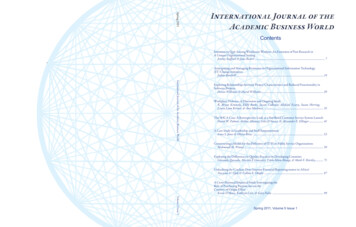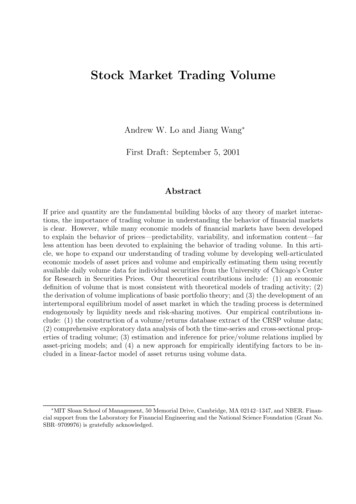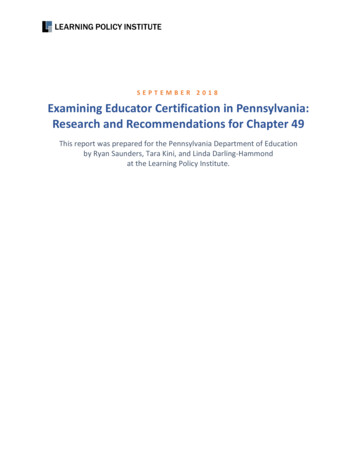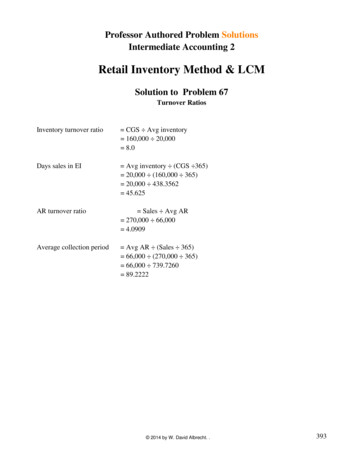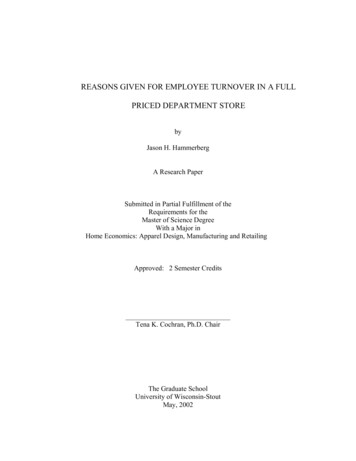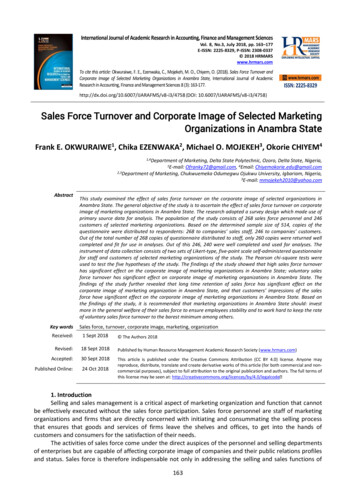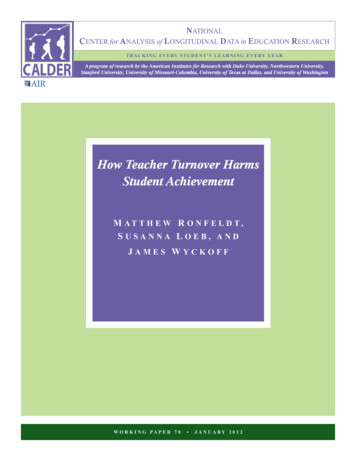
Transcription
NATIONALCENTER for ANALYSIS of LONGITUDINAL DATA in EDUCATION RESEARCHTRACKING EVERY STUDENT’S LEARNING EVERY YEARA program of research by the American Institutes for Research with Duke University, Northwestern University,Stanford University, University of Missouri-Columbia, University of Texas at Dallas, and University of WashingtonHow Teacher Turnover HarmsStudent AchievementM AT T H E W R O N F E L D T,SUSANNA LOEB, ANDJAMES WYCKOFFW O R K I N G PA P E R 7 0 JANUARY 2012
How Teacher Turnover Harms Student AchievementMatthew RonfeldtUniversity of MichiganSusanna LoebStanford UniversityJim WyckoffUniversity of Virginia
ContentsNotes . iiAbstract . iiiIntroduction . 1Data. 7Methods . 9Results. 14Discussion . 21Notes . 24References . 26Figures . 29Tables . 31Appendix . 42i
CALDER working papers have not gone through final formal review and should be cited as working papers. Theyare intended to encourage discussion and suggestions for revision before final publication.The views expressed are those of the authors and should not be attributed to the American Institutes forResearch, its trustees, or any of the funders or supporting organizations mentioned herein. Any errors areattributable to the authors.CALDER American Institutes for Research1000 Thomas Jefferson Street N.W., Washington, D.C. 20007202-403-5796 www.caldercenter.orgii
How Teacher Turnover Harms Student AchievementMatthew Ronfeldt, Susanna Loeb, and Jim WyckoffCALDER Working Paper No. 70January 2012AbstractResearchers and policymakers often assume that teacher turnover harms student achievement,but recent evidence calls into question this assumption. Using a unique identification strategythat employs grade-level turnover and two classes of fixed-effects models, this study estimatesthe effects of teacher turnover on over 1.1 million New York City 4th and 5th grade studentobservations over 10 years. The results indicate that students in grade-levels with higherturnover score lower in both ELA and math and that this effect is particularly strong in schoolswith more low-performing and black students. Moreover, the results suggest that there is adisruptive effect of turnover beyond changing the composition in teacher quality.iii
IntroductionTeacher turnover rates are high, particularly in schools serving low-income, non-white, and lowachieving student populations. Nationally, about 30 percent of new teachers leave the profession afterfive years, and the turnover rate is 50 percent higher in high-poverty schools as compared to moreaffluent ones (Ingersoll, 2001). Teacher turnover rates also tend to be higher in urban and lowerperforming schools (Hanushek, Kain, and Rivkin, 1999).Researchers and policy makers often assume that teacher turnover harms student learning.There are many reasons to think it would, as institutional memory is lost and resources are spent on thehiring process. On the other hand, the organizational management literature has demonstrated thatsome amount of turnover may in fact be beneficial to institutions and individuals. Institutional turnovercan, for example, result in better person-job matches and infusion of new ideas into organizations(Abelson & Baysinger, 1984). To this point, Jackson (2010) recently demonstrated that poor person-jobmatches predict migration and that teachers tend to be more productive in their new schools. Theinstitutional benefits of turnover can be enhanced if it is the less effective employees who leave.Yet, there exists little empirical evidence for a direct effect of teacher turnover on studentachievement (Guin, 2004; Ingersoll, 2001). Most existing research on the relationship between teacherturnover and student achievement has revealed negative correlations. For example, Guin (2004) studied66 elementary schools in a large urban district to look at relationship between school-level turnover andthe proportion of students meeting standards on statewide assessments in reading and math. Pearsoncorrelations were significant and negative, demonstrating that schools with higher turnover also hadlower achievement. These results are consistent with other correlational evidence showing schools withmore teacher turnover tend also to have lower-achievement (Boyd et al., 2005; Hanushek, Kain, andRivkin, 1999). Such evidence, though, is not necessarily causal, as a third factor (e.g. poverty, workingconditions, or poor school leadership) may simultaneously cause both low achievement and higher1
turnover. Even if we assume the relationship is a causal one, its direction is unclear – teachers leavingmay cause low achievement but low achievement may also cause teachers to leave. To date, this studypresents the best, pseudo-causal estimates for a direct effect of teacher turnover on studentachievement.“Compositional” ExplanationsMost scholars who suggest teacher turnover to have a direct, causal effect on studentachievement use explanations that we categorize as “compositional”. They focus on the difference inquality between teachers who leave (leavers) and those who replace them to account for the overalleffect of turnover on student achievement. When leaving teachers are, on average, worse than thosewho replace them, the effect of turnover on student achievement is assumed to be negative. Incompositional explanations, the distribution of teacher quality alone is thought to drive any effects ofturnover on student achievement.In such accounts, discussion about the harmful impact of teacher turnover tends to focus onlow-income, low-achieving, and high-minority schools which typically have less qualified and lessexperienced teachers, as well as higher turnover rates (Carroll et al., 2000; Clotfelter et al, 2007;Hanushek et al., 2004; Ingersoll, 2001). Darling-Hammond and Sykes (2003) argue that teacher turnoverhas a compounding effect on low-income schools. Teachers leave before they gain the necessaryexperience to become effective. When they leave, low-income schools have a difficult time attractingnew teachers so end up hiring inexperienced and less prepared teachers.Just because newly hired teachers tend to be inexperienced and unqualified, however, does notnecessarily imply that turnover is harmful. It is possible, for example, that hired teachers are slightly lessinexperienced and unqualified than those they replaced. Though the harmful effects of having less2
experienced and qualified teachers in low-income schools are obvious, the harmful effects of turnoverare less so.In fact, a growing body of evidence indicates that more effective teachers are at least as likely,and sometimes more likely, to stay in schools than their less effective peers, and that this is true even inschools with historically underserved student populations (Boyd et al., 2010; Goldhaber, D., Gross, B.,and Player, D., 2007; Hanushek & Rivkin, 2010; Murnane, 1984). Boyd et al. (2010) studied data onteachers’ applications for transfer to uncover which teachers are more likely to want to transfer fromNYC schools. They discovered that teachers who produced higher achievement gains and those withmore experience were less likely to apply for transfer.1 This reduced interest in moving held true evenfor teachers in the lowest-performing schools. Murnane (1984) found evidence for selective attrition ofless productive teachers, as signaled by principal ratings and prior student achievement, out of onelarge, urban district. Similarly, Hanushek and Rivkin (2010) found that, in Texas, those who left a givenschool tended to be less effective than those who stayed. Contrary to common assumptions, the relativeeffectiveness of stayers as compared to leavers was actually highest in schools with more low-achievingand black students. In other words, the resulting net distribution of teacher quality seemed to benefitschools with historically underserved student populations the most.In demonstrating that less effective teachers are more likely to leave than more effectivecounterparts, the studies described above suggest turnover may be beneficial. However, none of thesestudies directly tested whether the teachers who filled vacancies in a given school were more effectiveon average than those they replaced. Without knowing the net distribution of quality that results, it isthen difficult to draw conclusions about the overall impact of turnover. Recognizing this point, Hanushekand Rivkin (2010) did simulate the impact where only “rookie” teachers replaced exiting ones, and foundno overall effect of turnover on student achievement.3
The results of the Hanushek and Rivkin (2010) simulation are an important challenge to thecommonly held assumption that teacher turnover harms student achievement, especially that of lowperforming, low-income, and non-white students. However, their findings have important limitations,even aside from being simulated, rather than observed, effects of new hires. Like all compositionalaccounts, the results assume that the only lever by which teacher turnover harms or helps studentachievement is by adjusting the composition of teachers that make up a school’s faculty. But turnovermay impact student achievement beyond the relative effectiveness of those who stay as compared tothose who leave. This study contributes to existing literature by considering mechanisms for the effectsof turnover beyond changes to the distribution of teacher quality.“Disruptive” ExplanationsThe compositional explanations described in the previous section indicate that students benefitwhen they get teachers who are more effective than the ones that left the school. Effectiveness isthought to be something that individual teachers bring with them (or not). The overall effect of turnoverdepends upon the resulting distribution in effectiveness of individual teachers. If leaving teachers areequally as effective as those who replace them then there should be no net effect of turnover. In suchcompositional explanations, any turnover effects are driven only by leavers and their replacements. Thestudents of teachers who stay in the same school from one year to the next then are merely bystanders,presumably unaffected by turnover.However, others have suggested that turnover can have a broader organizational influence thatreaches beyond leaving teachers, replacement teachers, and their students. Where turnover isconsidered to have a disruptive organizational influence, all members of a school community arevulnerable, including staying teachers and their students. In such disruptive accounts of turnover, evenwhen leaving teachers are equally as effective as those who replace them, turnover can still impact4
students’ achievement. In this section we consider prior literature that suggests a disruptiveorganizational impact of turnover that may, in turn, influence student achievement.There exists substantial evidence that staff cohesion and community are related to studentengagement and achievement (Bryk, Lee, & Holland, 1993; Bryk & Schneider, 2002; Johnson, Berg,Donaldson, 2005; Little, 1982; Louis & Marks, 1998). According to Bryk and Schneider (2002), the qualityof relationships (trust) between teachers, and between teachers and students, predicts studentachievement. Likewise, Little (1982) found “patterned norms” of interaction among colleagues that alsopredict student achievement. When teachers leave schools, previously held relationships and relationalpatterns are altered. To the degree that turnover disrupts the formation and maintenance of staffcohesion and community, it may also then effect student achievement. Guin (2004) shows that teacherturnover indeed has a negative effect on faculty interactions and school climate. Likewise, recent studyby Hanselman et al. (2011) indicates that teacher and principal turnover has a disruptive effect on the“development and maintenance of social resources” (p. 27) – including staff collegiality, community, andtrust - in a school. Moreover, these authors found the impact of turnover to be initially detrimental to“high resource” schools and initially beneficial to “low resource” schools. In other words, the disruptiveinfluence of turnover can have either positive or negative effects depending upon a school’s initialconditions.School instructional program coherence has also been shown to predict student achievement(Newman et al., 2001). Since staff turnover presents significant challenges to the successful andcoherent implementation of such instructional programs (Guin, 2004), it also may harm studentachievement. With leaving teachers goes organizational knowledge important to the effectiveimplementation of such programs (Abelson & Baysinger, 1984). Moreover, newly hired teachers initiallylack essential knowledge and skills to implement an unfamiliar instructional program, so must bebrought up to speed before institutional progress can be made. The result in settings with persistent5
turnover then is that schools are always starting over rather than making progress on theirprogrammatic agendas.Turnover has substantial impact on the financial and human resources in districts and schools aswell. There are significant financial costs associated with recruiting, hiring, and training new teachers(Barnes et al., 2007). This drains resources that might otherwise be spent on program improvement orworking conditions, likely harming schools with historically underserved student populations the most(Barnes et al., 2007; Carroll et al., 2000; Darling-Hammond & Sykes, 2003). Underserved schools tend tohave more persistent turnover so suffer higher costs in keeping their classrooms staffed; moreover, theytend to have fewer resources to begin with, making it more difficult to absorb the cost of turnover or toinvest in costly program improvements. Typically new hires in underserved schools are less qualified sorequire substantially more remediation and often leave before gaining necessary expertise (DarlingHammond & Sykes, 2003; Carrol et al., 2000). Given these reasons to expect turnover to be especiallyharmful to historically underserved student populations, this paper looks separately at the effects ofturnover in such settings.Contrary to compositional explanations that assume stayers to be unaffected by turnover,disruptive explanations indicate that stayers may indeed be affected. Because they bear much of theresponsibility for mentoring new teachers about school expectations and programs, turnover likelyimpacts stayers directly (Guin, 2004). Stayers must carry more of the instructional burden and have lessprofessional development resources available to them, as available resources get used up on new hires(Shields et al., 1999/2001). Persistent turnover may then have a debilitating impact on staying teachersand, in turn, their students.Above we have provided a review of literature that describes many plausible mechanisms - bothcompositional and disruptive - by which teacher turnover likely effects student achievement. Becauseprior research has not adequately established a direct, causal link between teacher turnover and6
student achievement, however, we may be accounting for a phenomenon even before establishing thatit exists. Using a unique identification strategy, and two classes of fixed-effects regression models, thisstudy presents the cleanest estimates to date for a direct effect of teacher turnover on studentachievement. After establishing evidence for a direct effect of turnover on student achievement, thispaper begins to explore possible mechanisms to account for the observed effect.Three research questions guide the investigation: What is the average effect of teacher turnoveron student achievement? Are the effects different for different kinds of schools? What explains therelationship between teacher turnover and student achievement? To address the latter question, thisstudy explores whether observed effects are compositional or disruptive in nature. The paper proceedsas follows. We first describe the data and methodological approach. We then present the results andconclude with a discussion of the implications of the findings.DataThis study draws on extensive administrative data from the New York City Department ofEducation and the New York State Education Department. Analyses focus on approximately 1.1 millionobservations of 4th and 5th grade students across all New York City elementary schools over tenacademic years (2001-2010).2 We were able to link student test scores in math and ELA to student, class,school, and teacher characteristics.Table 1 describes student-year, teacher-year, and school-by-grade-by-year characteristics.About 70 percent of students in 4th and 5th grades in NYC were either black or Hispanic. Over one-thirdof students had a home language other than English, and 71 percent were on free or reduced pricedlunch. Approximately one percent of students had been suspended in the previous year, while ninepercent had switched schools since the prior year. Finally, students were absent for an average ofapproximately 11 days in the previous year.7
On average, 73 percent of teachers each year had stayed in the same school from the prior year(stayers). Approximately two percent of 4th and 5th grade teachers had transferred schools within NYC(movers), while 18 percent were first year teachers. The 4th and 5th grade teachers in the district had, onaverage, eight years of experience. Each 4th and 5th grade within each NYC school had, on average, fiveteachers, with a range from one to as many as 20 teachers. Figure A plots the distribution of teachersper grade in the sample schools.Our identification strategy requires measuring school-by-grade level turnover in each year. Suchmeasurement is not entirely straightforward. To illustrate, imagine a 4th grade within School A that hadsix teachers in year t-1. Due to increasing enrollments, in year t there were seven 4th grade teachers. Ofthese, five were stayers, one a mover, and one a first year teacher. Teacher turnover could be estimatedas the proportion of year t-1 teachers that were no longer in the 4th grade in School A in year t (1/6 16.7percent). On the other hand, turnover could be measured as the proportion of teachers that were newto the school-by-grade in year t -- either first year teachers or movers (2/7 28.6 percent). The firstmeasure -- “lagged attrition” -- defines turnover as the proportion of teachers in a given grade level inyear t-1 who left the school by year t. The second measure -- “proportion new” -- defines turnover asthe proportion of teachers in a given grade level who are new (movers or first year teachers) to theschool in year t. We used both measures in all analyses to test whether results were robust across them;the distributions for school-by-grade lagged attrition (averaged over 10 years) can be seen in Figure Band for school-by-grade proportion new (averaged over ten years) in Figure C. The measures havesimilarly shaped distributions, bell shaped with a right skew.The average teacher turnover rate in each grade in each school in each year was similar for bothof the measures we developed: 0.29 for the lagged attrition measure and 0.28 for the proportion newmeasure. Thus, each year, approximately three out of every ten 4th and 5th grade teachers in NYC left orcame to a given grade level in a given school. The two measures were moderately correlated with one8
another at the school-grade-year level (r 0.559). Lagged attrition could result from teachers leaving theprofession altogether or transferring to another school. This measure does not include the transfer ofteachers from one grade to another within the same school. We chose not to include this behaviorbecause, in such cases, the expertise of teachers would remain within the same school.3 About one-thirdof school-by-grades experienced no teacher turnover each year (between 30 percent and 33 percent).On the other hand, each year around four percent of 4th and 5th grade level teams had turnover rates of100 percent.4MethodsAs described above, three questions drive our analyses: What is the average effect of teacherturnover on student achievement? Are the effects different for different kinds of schools? And whatexplains the relationship between teacher turnover and student achievement?What is the average effect of teacher turnover on student achievement? Typically teacherturnover is measured at the school level. However, high turnover rates in the 6th grade may have littleimpact on incoming 4th grade students, especially when the 4th grade level team stays intact. To get amore precise estimate of the effects of turnover, this study examines turnover at the school-by-gradeby-year level, rather than at the school or school-by-year level. Another benefit of examining school-bygrade-by-year level turnover is that we can adjust for school-by-grade or school-by-year level factorsthat could influence both student achievement and turnover. For example, if the school’s principalleaves then the transition could simultaneously affect both turnover and achievement. If we do notmeasure this effect then our results would be biased, showing an association between turnover andachievement even if no causal relationship exists. Focusing on school-by-grade-by-year level turnoverallows us to adjust for school-by-year level factors, both observed and not observed.9
For each analysis we use two different estimation strategies to study the effects of school-bygrade-by-year level teacher turnover on student achievement. First, we use regression models withschool-by-grade fixed effects to leverage variation in turnover across years within the same grade leveland school. This allows us to examine whether students within the same grade level and within thesame school had better or worse test score gains in a given year, as compared to other years whenteacher turnover was at different rates. These models assume that the effects of turnover in the sameschool and grade level are comparable across years. These models are prone to school-by-year levelfactors, like bringing in a new principal, that may influence both teacher turnover and studentachievement, and thus make such an assumption problematic. All models control for prior studentachievement, but we also control for other student, class, school, grade, and teacher characteristicsdepending on the analysis. Equation 1 summarizes the regression model used for these analyses:Aitgsy β0 β1Aitgs(y-1) β2OtherAitgs(y-1) β3Χitgsy β4Ctgsy β5Ssy ϕy νgs β6Tgsy εitgsy (1)The test performance of individual, i, with teacher, t, in grade, g, in school, s, in time, y, is a function ofhis/her test performance in that subject, A, and the other subject, OtherA, in the prior year, studentbackground characteristics, X, time varying classroom characteristics, C, time varying schoolcharacteristics, S, year fixed effects,ϕ , grade-by-school fixed effects, ν, the grade-by-school-by-yearturnover measure, T, and an error term, ε.In our second method of analysis, we use school-by-year, instead of school-by-grade, fixedeffects to capitalize on turnover variation across grades within the same year and school. The advantageof the second method is that year-to-year variations – like bringing in a new principal, as describedabove - cannot explain observed effects; however, the disadvantage is that it assumes turnover rateshave comparable effects on student achievement at different grade levels. All models control for prior10
student achievement, but we also control for other student, class, school, grade, and teachercharacteristics depending on the analysis. Equation 2 describes the second method of analysis:Aitgsy β0 β1Aitgs(y-1) β2OtherAitgs(y-1) β3Χitgsy β4Ctgsy β5Ssy ϕg νsy β6Tgsy εitgsy (2)The test performance of individual, i, with teacher, t, in grade, g, in school, s, in time, y, is a function ofhis/her test performance in that subject, A, and the other subject, OtherA, in the prior year, studentbackground characteristics, X, time varying classroom characteristics, C, time varying schoolcharacteristics, S, grade fixed effects,ϕ , year-by-school fixed effects, ν, the grade-by-school-by-yearturnover measure, T, and an error term, ε.Are the effects of turnover different in different kinds of schools? To better understand thenature of observed effects, we examined whether the relationship between teacher turnover andstudent achievement varied in different kinds of schools. As described in the introduction, many havesuggested turnover to be a particularly pernicious problem in schools with historically underservedstudent populations, especially given that the turnover rates tend to be higher in these kinds of settings.To test whether the effects of turnover are different in schools with these populations of students weran models separately in low versus high performing schools, and in low versus high percentage blackschools. We did this by constraining our sample only to schools whose students averaged below the testscore mean and then reproducing the analyses described above. We then repeated this process with oursample constrained only to schools that had 20 percent or more black students.5 For comparison’s sake,we also examined schools with students scoring at or above the mean on test scores, and with blackstudent populations of less than 20 percent.Additionally, during the period of this study, NYC opened a number of new schools, many ofwhich were small and expanding. Given the unique challenges that new schools face, high rates of11
teacher turnover are more common in these new schools (Hemphill et al., 2009). National trends alsoindicate that small schools tend to have higher rates of teacher turnover (Ingersoll, 2001; Ingersoll andRossi, 1995). We wondered whether the effects of turnover might then be particularly salient in newand small schools in NYC. Moreover, some have suggested school size to be related to staff cohesionand community (Bryk et al., 1999), which, as described in the introduction, predict both teacherturnover and student achievement.To explore whether the effects of turnover may vary in new and in small schools, we ran modelsseparately for large versus small schools, and for new versus old schools. We chose median values ascutoffs in order to ensure that sample sizes in each group were similar. More specifically we classified“new” schools as not yet existing in 2001 and “old” schools as existing in or prior to 2001, and ranmodels separately for each group. We then classified “small” schools as having fewer than four teachersper grade level and “big” schools as having four or more teachers per grade level, and ran analysesseparately for each group.What explains the relationship between teacher turnover and student achievement? Asdescribed in the introduction, there are multiple potential mechanisms leading to the effects of turnoverthat we estimate in Equations 1 and 2. For example, turnover may affect achievement because theteachers who replaced those who left were either more or less effective (we refer to this as the“compositional” explanation). Alternatively, even where the arriving and leaving teachers were equallyeffective, the turnover itself may cause a broader disruption that impacts all students, includingstudents of teachers who did not transition (we refer to this as the “disruption” explanation).To examine the effect of differentially effective teachers (compositional explanation) we addteacher experience indicator variables for the number of years of experience for each teacher in ourdata set (leaving out first year teachers as the reference grou
turnover indeed has a negative effect on faculty interactions and school climate. Likewise, recent study by Hanselman et al. (2011) indicates that teacher and principal turnover has a disruptive effect on the "development and maintenance of social resources" (p. 27) - including staff collegiality, community, and trust - in a school.
